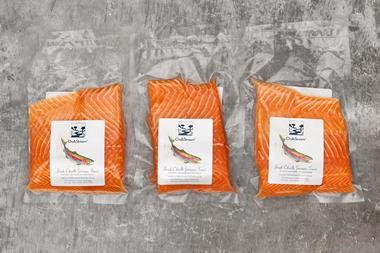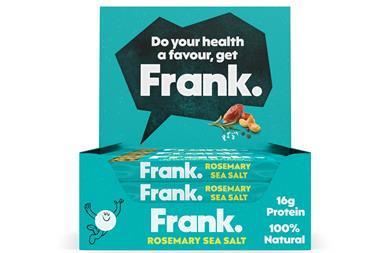Own label dominates in the fresh produce category but brands are forcing their way into the public's consciousness. Rice and pasta are providing intense competition to potatoes, for example, and it is hoped that brands such as Jersey Royals, Branston and Rooster potatoes will reduce this threat.
John Hicks, marketing manager at Albert Bartlett, which produces Rooster potatoes says: "In building the Rooster brand we have endeavoured to bring some excitement to a basic commodity and, in doing so, try to address some of the issues that are causing the potato category to lose sales to the other carbohydrates.
"Rooster is an excellent potato variety, which we have taken further by branding and retailing in packs endorsed by Michelin Star chef Andrew Fairlie and carrying recipes by him.
"The idea is to excite people about potatoes. We need to make potatoes fashionable again."
Provenance has been key to the marketing of Jersey Royals and many other brands, and it has given the new potato brand the attention it sought. Volumes exported last year were up 25% on the previous year and research has shown that 95% of consumers recognise the brand name.
The challenge is to duplicate this success across the category by further raising the profile of brands and introducing new ones. This will not be easy, however, because of opposition from the multiples keen to keep brands to a minimum.
Nevertheless, brand extensions are bound to filter on to the market and Redbridge, for one, is investing heavily to develop new fruit and veg varieties.
The company is on the verge of launching a new strawberry variety - the name of which will be left to the general public in a "naming the fruit" competition co-ordinated through a yet undisclosed retailer.
MD Richard Parke-Davies says: "For a brand to be successful it has to be unique, but retailers don't really encourage brands in fresh produce because it is difficult to manage the availability through the chain. We will only see more brands if there is innovation that consumers are prepared to pay for, and this will inevitably be in niche markets."
Bagged salad brand Florette recently refreshed its brand image with new packaging and logo and the presentation of its salads as "restaurant quality".
MD Mark Newton says: "You only have to look at the success of brands to see the proof that there is a role for them. There may be suppliers out there wanting to get in on the act, but it would take a bold marketing effort to launch something new on to a market like bagged salads, which has reached maturity. We have invested several million a year in marketing Florette."nFlorette has sourced recipes and ingredients from travel destinations for its A Taste Of..collection. Recipes include Morocco - lollo rosso and baby leaf Romaine with orange vinaigrette, apricots and pumpkin seeds; Italy - wild rocket and ruby chard with a sun-dried tomato and balsamic dressing; and Thailand - a fragrant combination of Escarole, Mizuna, coriander and Thai basil with a Thai green dressing sprinkled with lime and poppyseeds.
?A trademarked wholehead lettuce called One-cut Salanova, which is easy to prepare with one cut across the base, is being stocked for the first time by M&S and Waitrose. The salanova is shaped like a rose and comes in three varieties - green leaf, a red/green variation sweeter than other pigmented types, and a sweet red/brown variety.
?Whole organic pineapples made their debut in Tesco in March this year. The pineapples come from the south of Togo, where they are grown in areas from the mountains to coastal plains by family growers, each managing a unit of about two hectares.
?Del Monte is targeting children with a bagged fresh fruit range launching this summer. The company is launching 80g bags of fruit pieces, include Juicy Apple Bites. MD Peter Miller says the range will make fruit more appealing to kids.
Ginsters has branched out into the snacking fresh fruit category with its own range for service stations. The company's Fruit Snack Pack contains a selection of fresh grapes, melon and pineapple slices with each bag counting towards two of the recommended five fruit and vegetables a day.Research Notes
Fresh produce in the UK continues to be a dynamic industry in value terms with value growing at 5.4% year-on-year - worth an incremental £370.6m - to £7.2bn. Growth is being driven by increases in frequency, price and trip volume. Consumers are purchasing produce an extra three times a year, averaging at once every four days. The average person consumes around 3.3 portions of fresh fruit and vegetables a day. However, this is a significant increase on last year's 2.5.
Fruit experienced a growth of 8.1% in comparison with vegetables, which grew by 3.1%.
Stone and soft fruit are the top performing fruits, with a 35.4% share and 16.5% growth year-on-year. Stone fruit is growing 11.8%, driven by the growth of apricots, up 21.2%, and cherries, up 17.7%.
Soft fruit is in growth, up 18.2%, driven by the steep growth of fruits such as blackberries (114%), blackcurrants (62%) and blueberries (75%).
Tropical fruit is growing by 8.7%, experiencing strong growth as a result of new buyers, price and a heavier buyer base, with households purchasing more throughout the year.
Pears are in growth of 3.1%, and apples are in decline of 2.4%. Both sectors have experienced a decline in price over the past year. Bananas on the other hand are seeing an increase in price of 7%.
The vegetable sector has experienced a growth of 3.1%. There has been a slight decrease in price and consumers now purchase produce on average once every five days, an extra two trips this year in comparison with last year.
Potatoes have had a major turnaround, down 2.8% compared with a growth of 11% last year. This is as a result of the significant decrease in price driven by supply and demand dynamics. Volume last year was up 1.5%, but this year is up 3.6%.
Sapna Sejpal, TNS Worldpanellooking back what we said in 2003
When we covered fresh produce in this section for the first time back in 2003 (The Grocer 7 June) brands were just starting to have a greater impact in the category.
Florette was driving growth in the bagged salads category, as it is today, and brands such as Cape and Outspan were also proving popular.
Three years ago the industry was being affected by issues that are still being felt today - price was still a key factor when it came to buying fruit and vegetables and brands were still not doing enough to convince consumers to trade up to their brands.
Hamish Renton, then planning manager for fresh produce at Tesco, said: "When customers want an orange, they have certain expectations and they get all that from own label. The branded player must say: 'you should pay more for my product and here's why. I don't think they are doing that'.
"There needs to be more investment in developing products that add value."
The industry was also tackling a problem that still hasn't been fully resolved today - how to make fruit and vegetables more appealing to children.
In 2003 Red Communications won the first fresh produce character licence to brand a variety of fruit with Disney's Winnie the Pooh, although such a tactic hasn't proved to be a long-term solution for the industry and hasn't been used regularly since.
As Renton said at the time: "With licensing, you're not changing the characteristics of the product. Children want something smaller, shinier, sweeter and preferably bright purple."
That said, three years ago the industry was still recording growth in line with today's figures.
Total fruit and vegetables grew in value by 3% while packaged own label fruit and vegetables experienced a year-on-year sales increase of a whopping 12% to £177m.The buyer's view
We have a simple policy when it comes to fresh fruit and vegetables: quality, taste and excellence come first. The provenance of fresh produce is a big issue at the moment and the combination of provenance and sourcing within the UK ticks a lot of boxes with consumers - it also cuts down on food miles. But provenance is sometimes best achieved through sourcing overseas and so you will see products such as France's Lautrec garlic in our stores, among others.
The proportion of regional fruit and vegetables we have in our stores changes due to the seasonality of fresh produce, but at certain times of the year 87% of our range is British. During the tomato season we sell around 98% English tomatoes.
Locally, we work with growers and producers that are artisan producers and are too small to trade with the major multiples. That is the advantage of being a smaller retailer - the supply chain is less complicated (we have one food distribution centre) and we have direct links with our suppliers. It's a favourable symbiotic relationship.
The grower's view
Blackcurrant growers in the UK produce 13-15,000 tonnes a year of fruit but only a small quantity (about 5%) of the crop is sold as whole fruit - the remaining 95% is used to produce Ribena.
We are doing a lot of promotional work to raise awareness of UK blackcurrants. Blackcurrants were sold for £150 per tonne last year and if we hadn't had Ribena the market would have collapsed. One thousand tonnes were sold as fresh produce in 2005. But there is a lot of wastage because there is not enough demand for UK blackcurrants.
The trouble is we have to contend with cheaper, lower quality imports from Poland. The imports from Poland aren't taxed so there is a big pollution issue here, and I'm sure that this sort of negative issue will be brought up more and more. The competition has destroyed the infrastructure of the industry over the years but we are trying to rectify this.
Our main markets should be fresh fruit, frozen fruit, jams and toppings, and we are trying to re-establish ourselves within these markets.



















No comments yet